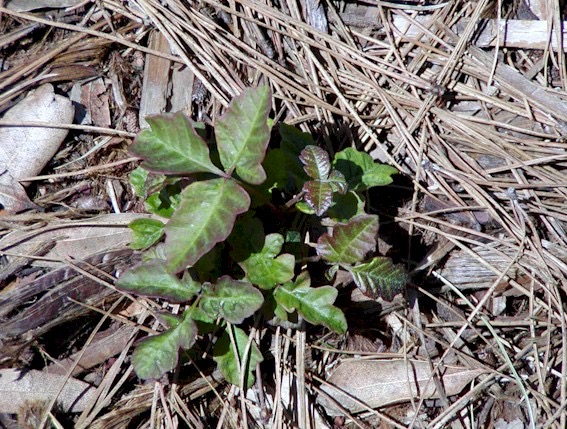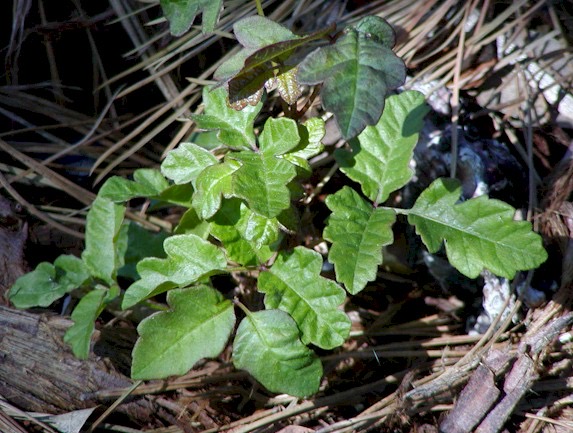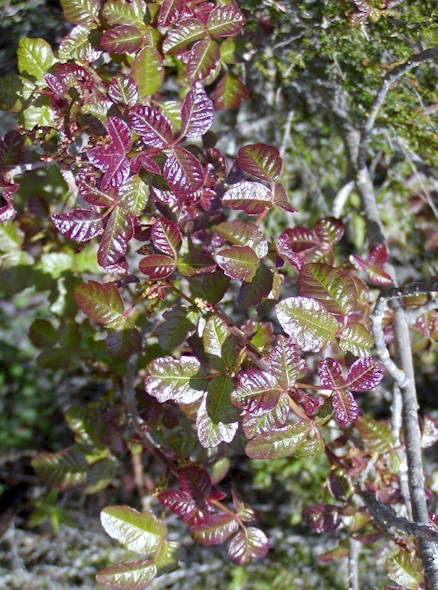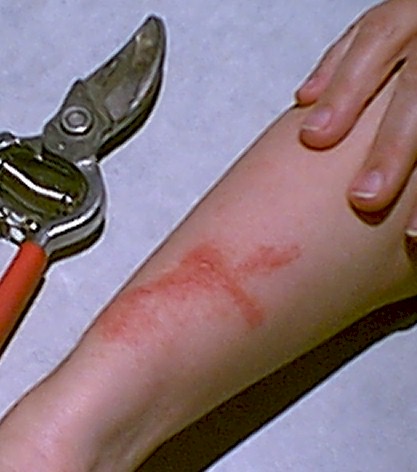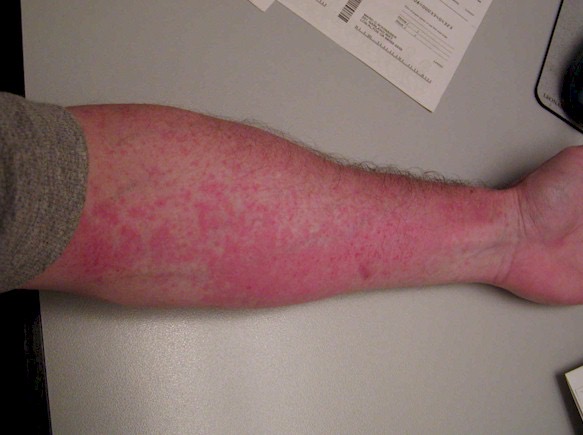If you spend enough time crashing around Sonoma County, you are likely to run into some poison oak. We have numerous times, so this is a page to let you know what we have learned through lots of trial and error.
If you don't know what the plant looks like, there are some photos to the right. In general remember that poison oak has "leaves of three" and the leaves and stems have no points or prickers whatsoever. Wild blackberry and scrub oak look very similar to poison oak, but both have prickers and pointed leaves. It can be small or large, shrubby or vine-like and is usually intermingled with other plants so you don't notice it immediately. We try and keep our trails free from poison oak, but shoots can appear quickly. The small shoots shown here could be around 1 to 2 weeks old.
Most people get a rash from exposure to the oil in the plant (the oil is called urushiol). It is incredibly potent and it only takes a few micrograms of oil to create a nasty rash. It is invisible and odorless. If you don't think you are sensitive to the plant, you should still be careful as you can develop increased sensitivity over time. The oil penetrates the skin in about an hour and locks into a fairly deep epidermal layer. The rash develops 12 to 72 hours later.
There appear to be two types of exposure: Topical and Systemic.
With topical exposure, you get a very localized rash where you have been exposed to the oil. This rash appears in well defined streaks or clumps and is usually raised and blistered.
Systemic exposure seems to occur from more concentrated exposure to the oil, or by other introduction of the oil into your body (like through a cut or dust exposure/inhalation, or other source). Systemic rashes are more widely spread and can appear in different places in your body that were not directly exposed. They are very diffuse and "rash-like" compared to the topical sores.
Check out the photos to see what happens to your body. The first picture is a topical exposure, the second is systemic. It itches.
Note that the rash is not contagious. If a rash develops somewhere, it is because it was exposed to the oil either topically or systemically.
What works:
Ivy Block - This is something you apply to prevent contact with the oil of the plant. You put it on like sunscreen 20 minutes before you head out into the woods. www.ivyblock.com
Tecnu - This is a soap that incorporates a chemical that wil neutralize the oil. We always wash with this after doing any trail work. We have tons of it at Elarra. You have to wash with it within a few hours of contact for it to be effective. It's about $10 a pint but worth every penny. If you don't have any of this and think you have been exposed, you can also wash with rubbing alcohol, followed by cool water. It is not as effective, but it is better than nothing. www.teclabsinc.com
Yerba Santa - A plant that grows wild in Sonoma (see our wildflower section for more on this). There is a lot of it around Elarra. We have seen this work well for topical exposures. It will remove the rash in about 24 hours when applied as a very hot poultice.
Zanfel - At $40 a small tube, this stuff better work! This is a soap that will extract the oil once you have contracted the rash. It stops the itch within about 30 seconds. Claims to heal topical exposure, our experience is that is will largely arrest the progress, relieve the itching. Instead of a 6 week ordeal, it becomes a 2 week tolerable situation. It also relieved itching for hours at a time on a nasty systemic exposure. www.zanfel.com
Prednisone - This is a mind bending steroid that you need a prescription for. It is the tool of last resort as it is not tame stuff. Use this to cure a systemic exposure. Taking a light dose will not work. You need to do a tapered program starting with 60mg per day. Here is a reference to take to your doctor.
Really hot water - To relieve the itching (assuming you don't have Zanfel handy) you can rinse the rash in very hot water - like as hot as you can stand. This will cause a tremendous release of histamine and it will itch like crazy for about 15 seconds while you blow all the histamine out of the area. After this treatment the itching will be gone for a few hours. It is the only way we have found to deal with itching without the above.
Antihistamine - A friend of ours claims that Claratin cleared her rash up quickly, and she is pretty allergic to the plant. This hasn't worked for us, but it is worth a try!
What may work, but we are not sure yet
There are some homeopathic pills you can take at very low doses which is supposed to convince your body that urushiol isn't so bad after all. We are experimenting with this, but can't yet confirm it works from personal experience.
What is basically useless.
Calamine lotion
Cortizone creams
What you shouldn't do!
Don't mess with the plant at all. The oil is invisible, spreads all over the place and can last for years on surfaces. Wash any thing you think was exposed to the oil. Your shoes are a prime candidate. You can continue to re-infect yourself with the oil if you don't clean it up. Even if you aren't sensitive to the oil you can put others in harms way.
Digging anywhere around the plants is hazardous. Poison oak plants have long root runners, and the roots have beaucoup oil!
Never take a bath if you think you have been exposed! The oil will float and cover your entire body!
Never burn poison oak! Inhaling the smoke can do really bad things to your lungs.
Don't try to cure an exposure with homeopathics (even though they suggest it on the box). In our experience it caused a systemic reaction to really crank up.
